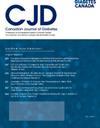The First Nations Community Experiences With the SOAR Research Program: Improving Type 2 Diabetes Prevention and Management
IF 2.6
4区 医学
Q3 ENDOCRINOLOGY & METABOLISM
引用次数: 0
Abstract
Objectives
Indigenous peoples in Canada are considered the highest risk populations for type 2 diabetes mellitus (T2DM). Quality improvement (QI) strategies may be considered effective interventions for improving T2DM health outcomes. The purpose of this study was to understand experiences associated with implementation of the SOAR QI program to improve prevention and management of T2DM.
Methods
A qualitative study was conducted, and in-depth, semistructured interviews were held with QI team members and key contacts, in person and through videoconference with 2 First Nations communities. Interviews were audio-recorded and transcribed for data analysis.
Results
Ten interviews were conducted and emerging themes from the data analysis were organized into 2 categories: facilitators and barriers. Four subthemes were identified. Two subthemes emerged under the category of facilitators (cultural relevance and partnership building) and 2 subthemes emerged under the category of barriers (workload burden, role ambiguity).
Conclusions
This study highlights the necessity of implementing diabetes QI strategies that foster cultural sensitivity and provide opportunities for partnership building to strengthen community relationships. We also highlight the importance of diminishing role ambiguity and increased workload burdens, which can hinder the successful implementation of QI programs long term. Our findings can be used to improve future adaptations of SOAR and other diabetes First Nations–focussed QI strategies to benefit Indigenous people in acquiring optimal outcomes relative to T2DM care. Findings can also inform the design, practices, and policies of such QI interventions in support of the spread and sustainability of the intervention long term.
原住民社区对 SOAR 研究计划的体验:改善 2 型糖尿病的预防和管理。
目的:加拿大原住民被认为是 2 型糖尿病(T2DM)的高危人群。质量改进(QI)策略被认为是改善 T2DM 健康状况的有效干预措施。本研究旨在了解与实施 SOAR QI 计划相关的经验,以改善 T2DM 的预防和管理:本研究采用了定性研究的方法,对 QI 小组成员和主要联系人进行了深入的半结构化访谈,访谈由两个原住民社区亲自参加并通过视频会议进行。对访谈进行了录音和转录,以便进行数据分析:共进行了 10 次访谈,数据分析得出的新主题分为两类,即促进因素和障碍。确定了四个次主题。在促进因素类别下出现了两个次主题(文化相关性和建立伙伴关系)。在障碍类别下出现了两个次主题(工作量负担、角色模糊):本研究强调了实施糖尿病质量改进战略的必要性,这些战略应促进文化敏感性,并提供建立伙伴关系的机会,以加强社区关系。本研究还强调了减少角色模糊性和增加工作量负担的重要性,这些因素会长期阻碍质量改进计划的成功实施:本研究的结论可用于改进 SOAR 和其他以糖尿病原住民为重点的 QI 战略的未来调整,使原住民在 T2DM 护理方面获得最佳结果。研究结果还能为此类 QI 干预措施的设计、实践和政策提供参考,从而支持干预措施的推广和长期可持续性。
本文章由计算机程序翻译,如有差异,请以英文原文为准。
求助全文
约1分钟内获得全文
求助全文
来源期刊

Canadian Journal of Diabetes
ENDOCRINOLOGY & METABOLISM-
CiteScore
4.80
自引率
4.00%
发文量
130
审稿时长
54 days
期刊介绍:
The Canadian Journal of Diabetes is Canada''s only diabetes-oriented, peer-reviewed, interdisciplinary journal for diabetes health-care professionals.
Published bimonthly, the Canadian Journal of Diabetes contains original articles; reviews; case reports; shorter articles such as Perspectives in Practice, Practical Diabetes and Innovations in Diabetes Care; Diabetes Dilemmas and Letters to the Editor.
 求助内容:
求助内容: 应助结果提醒方式:
应助结果提醒方式:


